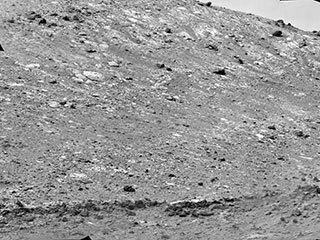Nestled within the vast expanse of Gale Crater on Mars, a scientific saga unfolds. For over a decade, NASA’s intrepid rover Curiosity has scaled the slopes of Mount Sharp, a geological marvel that holds the key to unlocking the Red Planet’s watery past.
Now, after an arduous climb, Curiosity has reached a new frontier – the Gediz Vallis channel, a captivating feature hinting at a time when liquid water sculpted the Martian landscape.
A Channel Carved by Time and Water
The Gediz Vallis channel bears the hallmarks of an ancient waterway. Its steep walls, a stark contrast to the gentle slopes carved by wind erosion, speak volumes about the powerful forces that once shaped this region. While billions of years have passed since water last flowed here, the channel’s form remains a testament to a bygone era.
Nature’s Gift: A Glimpse into the Unexplored
While the peak of Mount Sharp remains beyond Curiosity’s reach, nature has offered a helping hand. A colossal pile of rock debris, deposited by relentless Martian winds, spills out from the channel, forming a ridge accessible to the rover. This serendipitous event presents a golden opportunity – by studying these displaced rocks, scientists can glean valuable insights into the composition of the mountain’s otherwise inaccessible upper reaches.
A Piece of the Martian Puzzle
Mars’ hydrological history is an intricate puzzle, with each discovery adding another fragment to the bigger picture. Evidence abounds – hydrated minerals whisper tales of a distant past, sulfate deposits mark where water once evaporated, and high-resolution orbiter imagery reveals the unmistakable scars of ancient rivers and deltas. The Gediz Vallis channel, though a small piece of this Martian mosaic, has the potential to significantly enhance our understanding of this once-watery world.
Understanding Mount Sharp: A Layered History
Mount Sharp itself is a geological record book, its layers chronicling the eons that have transformed Mars. Over vast stretches of time, wind and water deposited sediments, forming distinct strata. The Gediz Vallis channel, however, appears to have been carved after this depositional phase, hinting at a period of renewed water activity.
Water’s Enduring Presence: A Story of Fluctuations
The presence of the Gediz Vallis channel aligns with other intriguing discoveries made by Curiosity. Mars’ water story appears to be one of episodic fluctuations, rather than a singular event. Water may have waxed and waned over time, defying simple narratives and posing a captivating challenge to scientists piecing together the planet’s climatic history.
A Closer Look: Gediz Vallis Ridge Unveils its Secrets
A year ago, Curiosity ascended the Gediz Vallis ridge, a sprawling debris field seemingly emanating from the channel’s end. This close-up examination revealed a crucial link – the similarity between the ridge material and the channel fill suggests a common origin, most likely a water-driven process.
Patience Unearths the Past: A Meticulous Investigation
While Curiosity is a marvel of engineering, unraveling the mysteries of Gediz Vallis will require months of meticulous exploration. The data collected by the rover’s instruments will be meticulously analyzed, offering a detailed picture of the channel’s formation and the secrets it holds about Mars’ watery past.
Aligning with the Bigger Picture: Curiosity’s Contribution
Recent research, incorporating data from Curiosity, strengthens the notion of episodic water flow on Mars. The study suggests that the bulk of Mount Sharp was built by waterborne sediments, followed by a period of windblown deposition. Interestingly, the windblown layer displays signs of deformation, hinting at a later resurgence of water activity.
The Intriguing Unknown: Untangling the Threads of Martian History
The exact role of the Gediz Vallis channel within the broader narrative of Mars’ water history remains unclear. Was it truly carved by a flowing river? Did water transport the colossal boulders that now fill the channel, or were they deposited by dry avalanches? These questions will be addressed as Curiosity delves deeper into this fascinating Martian feature.

The coming months hold immense promise as scientists delve into the data collected by Curiosity. Each new piece of information brings us closer to understanding the fascinating story of water on Mars, a story that continues to captivate and inspire our quest for knowledge.



















